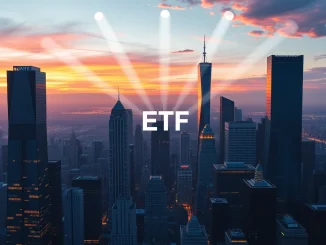
The crypto world buzzed recently with a significant **Ethereum withdrawal** that caught the attention of market observers. In early 2025, GSR Markets, a prominent player in the digital asset space, moved 2,708 ETH, valued at $9.87 million, from Binance to a private wallet labeled 0xdE6C. This was more than just a routine transaction; it was a calculated maneuver offering profound insights into the evolving landscape of **institutional crypto** strategies and prevailing **market sentiment**. For savvy investors, understanding the motivations behind such large-scale movements is crucial for deciphering near-term market dynamics and strategically positioning portfolios.
GSR Markets: A Deep Dive into Their Strategic Play
GSR Markets operates at the heart of the crypto ecosystem, functioning as a leading market maker. Their primary roles involve providing liquidity to exchanges and meticulously managing risk for vast digital asset portfolios. The recent **Ethereum withdrawal** from Binance aligns perfectly with several core institutional strategies, reflecting a sophisticated approach to digital asset management in a maturing market.
Enhanced Security and Counterparty Risk Mitigation
One of the foremost reasons for moving substantial assets from a centralized exchange to a private wallet is to bolster security and mitigate counterparty risk. Centralized exchanges, while convenient, are susceptible to hacks, operational failures, and regulatory pressures. For a firm like GSR, which manages hundreds of millions in digital assets, reducing exposure to these risks is a paramount concern. The destination address, 0xdE6C, already holds over $378 million in ETH, underscoring a long-term commitment to self-custody. This trend towards institutions prioritizing direct control over their assets has accelerated, particularly following high-profile incidents that highlighted the risks associated with leaving funds on exchanges. Self-custody provides an unparalleled level of security, reducing reliance on third parties and ensuring assets are held in environments less vulnerable to external threats.
Preparation for Over-the-Counter (OTC) Transactions
Large-scale transactions in crypto markets often occur over-the-counter (OTC) rather than directly on exchanges. OTC trades are preferred by institutional players because they help avoid significant price slippage and minimize market impact, which can be substantial when dealing with multi-million dollar orders. By withdrawing 2,708 ETH, GSR could be preparing to execute or receive a private transaction. This allows them to leverage their deep market expertise to optimize trade execution away from public order books, ensuring discretion and efficiency for large volumes. This strategy reflects a broader industry shift toward off-exchange settlements, which offer greater privacy and flexibility for major players.
Portfolio Rebalancing and Treasury Management
The withdrawal may also signal a strategic reallocation of assets across GSR’s extensive multi-exchange ecosystem. Consolidating ETH into a centralized treasury wallet provides the firm with greater flexibility to optimize liquidity for future opportunities. This could include deploying capital into decentralized finance (DeFi) protocols for yield generation, participating in Ethereum staking, or preparing for other strategic investments. This approach mirrors best practices in traditional institutional treasury management, where flexibility, responsiveness to market conditions, and efficient capital deployment are paramount. It allows for a more agile response to new market opportunities or shifts in investment strategy.
GSR’s Move and its Impact on Market Sentiment
The **Ethereum withdrawal** had an immediate, albeit subtle, impact on Ethereum markets. Within 30 minutes of the transaction, the ETH/USD pair experienced a slight dip of 0.5%, while trading volumes on Binance’s ETH/BTC and ETH/USDT pairs surged by 10–15%. These reactions highlight the intricate interconnectedness of institutional actions and broader retail market behavior. Understanding these immediate ripple effects helps gauge prevailing **market sentiment**.
Short-Term Volatility and Liquidity Dynamics
Large institutional withdrawals can temporarily reduce the liquidity available on an exchange. When a significant amount of an asset is moved off-exchange, it can thin out the order book, potentially amplifying price swings if demand remains constant or shifts. The observed spike in ETH/BTC trading volume on Binance suggests that retail traders reacted quickly, either by attempting to capitalize on the momentary dip or by seeking to hedge their positions against potential further declines. However, the absence of a prolonged sell-off following the withdrawal indicates that the market largely interpreted the move not as a bearish signal, but rather as a strategic repositioning by a major player, suggesting underlying resilience in **market sentiment**.
Bullish Undercurrents and Regulatory Clarity
Crucially, the fact that GSR moved these funds to a long-term storage wallet—rather than immediately liquidating them on an exchange—points to a strong underlying confidence in Ethereum’s long-term value proposition. This action mirrors broader **institutional crypto** trends, where sophisticated firms are increasingly treating digital assets as a strategic asset class rather than purely speculative plays. This confidence is further bolstered by recent regulatory developments. The Genius Act and Clarity Act, both passed in early 2025, have provided much-needed regulatory clarity for stablecoin and tokenization infrastructure. Ethereum, with its robust ecosystem, is a dominant force in these sectors, and clear regulations further solidify its appeal to institutional investors, reinforcing a generally positive **market sentiment**.
Leveraging On-Chain Analysis for Smarter Investing
For individual investors, the key takeaway from GSR’s move is to align personal strategies with institutional-grade risk management principles. This means adopting a more sophisticated approach to how digital assets are managed and how market signals are interpreted.
- Diversify Custody Solutions: Following GSR’s lead, consider allocating a portion of your crypto holdings to cold storage solutions like hardware wallets or reputable institutional-grade custodians. This significantly reduces exposure to exchange-specific risks, such as hacks or insolvency, and aligns with a long-term value preservation strategy.
- Monitor On-Chain Flows: Tools like Arkham Intelligence, The Data Nerd, or Glassnode can provide invaluable insights by tracking large wallet activity. Look for patterns in significant inflows to or outflows from exchanges, as these often precede broader market shifts. Understanding these movements through **on-chain analysis** can give you an edge in anticipating market direction.
- Balance Exposure to Ethereum and Altcoins: With Ethereum’s accelerating institutional adoption, consider increasing your allocation to ETH as a foundational asset. However, always balance this with stablecoins or low-volatility tokens to manage risk. The significant 27% surge in the ETH/BTC ratio in February 2025 highlighted Ethereum’s growing importance as a gateway for broader altcoin rotations and a key indicator of market strength.
- Leverage Derivatives for Risk Mitigation: The call-heavy positioning in Ethereum futures, indicated by a -11% 1-week Put-Call skew, suggests strong upside expectations among institutional traders. Individual investors can use options or futures contracts to hedge against potential volatility while maintaining exposure to upside potential. These tools allow for more nuanced risk management strategies.
In essence, **on-chain analysis** empowers investors to move beyond mere price charts and understand the underlying flow of capital, providing a deeper context for market movements.
Conclusion: Navigating the Institutional Tide
GSR’s substantial **Ethereum withdrawal** serves as a compelling microcosm of sophisticated **institutional crypto** risk management in 2025. By prioritizing security, optimizing liquidity, and demonstrating a clear long-term conviction in Ethereum’s value, the firm exemplifies how major players navigate an increasingly mature and regulated digital asset market. For individual investors, the lesson is clear: adopting institutional-grade strategies, staying attuned to powerful **on-chain analysis** signals, and positioning portfolios to benefit from Ethereum’s continued institutional adoption are vital steps. In a market where every large transaction tells a story about **market sentiment** and strategic intent, understanding these narratives is the first step toward making smarter, more informed investment decisions.
Frequently Asked Questions (FAQs)
Q1: What is the significance of GSR Markets’ Ethereum withdrawal from Binance?
A1: The withdrawal signifies a strategic move by a major institutional player to enhance security through self-custody, potentially prepare for large over-the-counter (OTC) transactions, and rebalance its portfolio for optimal liquidity and future opportunities like DeFi yield generation or staking.
Q2: How does an institutional withdrawal like this affect market sentiment and liquidity?
A2: Such withdrawals can temporarily reduce exchange liquidity, potentially leading to short-term price volatility. However, if the assets are moved to a long-term storage wallet rather than being sold, it can signal bullish confidence in the asset’s long-term value, preventing a prolonged sell-off and contributing to positive market sentiment.
Q3: What are the benefits of self-custody for institutional crypto firms?
A3: Self-custody provides enhanced security against exchange hacks, reduces counterparty risk (the risk of an exchange failing or freezing funds), and offers greater control and flexibility over assets, which is crucial for managing large-scale portfolios and executing private transactions.
Q4: How can individual investors use on-chain analysis to track institutional movements?
A4: Individual investors can use platforms like Arkham Intelligence or Glassnode to monitor large wallet activities, track exchange inflows and outflows, and identify significant transfers to or from known institutional addresses. This helps in understanding potential market shifts and institutional sentiment.
Q5: What role do regulatory acts like the Genius Act and Clarity Act play in institutional crypto adoption?
A5: These acts provide crucial regulatory clarity for stablecoins and tokenization infrastructure, reducing uncertainty for institutional investors. Clear regulations foster greater confidence, making it safer and more attractive for institutions to enter and expand their involvement in the crypto market, particularly in areas where Ethereum plays a dominant role.
Q6: Why is Ethereum increasingly seen as a strategic asset class by institutions?
A6: Ethereum’s robust ecosystem, its dominance in DeFi and NFT sectors, its ongoing transition to more efficient mechanisms like staking, and increasing regulatory clarity make it a foundational and strategic asset for institutions. Its utility and network effects position it as a key component for long-term digital asset strategies.



